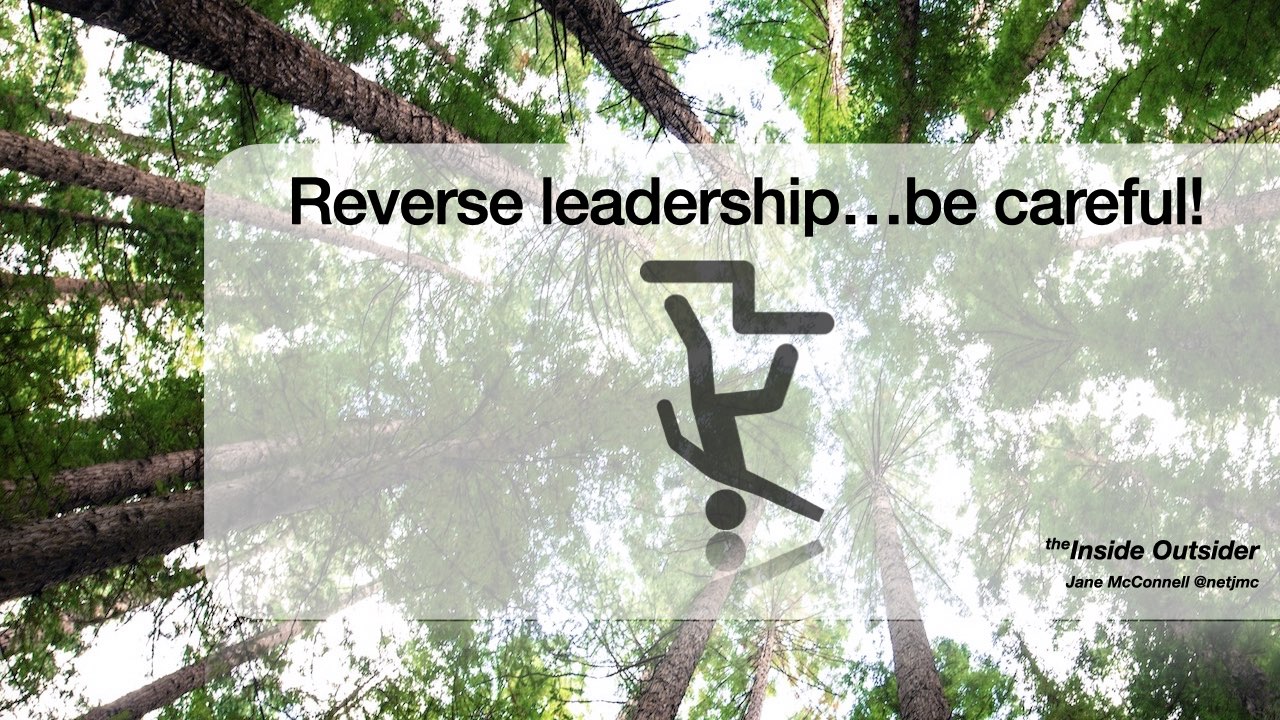6. If you are a reverse leader, take precautions
From Inside Outsider

From Inside Outsider

I wrote about reverse leadership in 2020 in my book The Gig Mindset Advantage – A Bold New Breed. I offered examples of what it means, and also what precautions you need to take. They include acting ignorant, listening to the edges, avoiding consensus, looking forward rather than back, and above all managing up.
Practice wise ignorance. Organizational theorist Karl E. Weick emphasizes how contradiction can be a powerful way to prepare for uncertainty. He discusses how a “spirit of contradiction” is more productive than a “spirit of accord” because it brings out a range of ideas that are more helpful when dealing with the unexpected than is a polite conversation where everyone reaches consensus.
Avoid consensus. It decreases resilience.
Open your mind and listen to the edges. Reverse leaders find ways to scan the horizon around them, exploring far beyond their own industry and country. Futurologist Joseph Voros talks about looking for signals or early trends that may develop more in the future that we will likely live through. He says “environmental scanning well is less about technique and methodology (although they are obviously important) and more about openness of mind.”
Open your mind and look for evidence of the future in the present
The forgetting curve is more important than the learning curve. Leaders in general and particular reverse leaders should not focus on best practices; which are by definition based on the past, but rather look for next practices according to C.K. Prahalad. This does not seem like reverse leadership at first glance, but it is the reverse of what most leaders do!
Look forward, not backward
Reverse leaders who stay in the background, invisible, and focus on enabling their teams to do their jobs better are admired for their lack of ego and desire to support others. But the risk is that they will be overlooked by their own management and potentially considered to be bringing little value to the organization.
A high-level manager in a UK-based healthcare organization explained: “In a hierarchical, top-down company, although nobody admits it out loud, you actually have to take credit for things your team does. You have to be seen to be the influential one. If I gave lots of credit to other people for the good things that happened, which I did, it looked to the very hierarchical manager that I wasn’t doing anything. But, in fact, everything I was doing was being done in the background. It was behind the scenes.
“All my work was behind the scenes”
“I was creating an environment in which people felt trusted and supported, psychologically safe, so that they would collaborate and experiment. And in doing those things, we would see value emerge from their interactions. But a hierarchical manager just doesn’t recognize that at all.”
So what can reverse leaders do?
The manage-up approach was suggested by a person I interviewed: “If there’s distance between you and the senior executives, the more nebulous it is what you do and how you’re identified. The harder it is for them to get a good grip on it unless they have been a direct project sponsor and you have built your internal brand with them. You need to manage up, and overcome the lack of a clear, consistent role definition. If not, you have a handicap.”
This makes good sense. Even if you work in such a way that you do not have a consistent role in the organization, you need to find ways to express what you do, keeping your manager in the loop.
_______________________________
Please share in the comments below, or directly with me via Twitter @netjmc or my website at https://netjmc.com/contact/
_______________________________
Also see: I also wrote a post for the Drucker Forum blog the year the theme was Leadership Everywhere which I twisted to say leadership everywhere means reversed leadership.
References from above:
Joseph Voros, Reframing Environmental Scanning, from the Australian Foresight Institute in 2003
Weick refers to the concept of a “spirit of contradiction” used by Eric-Hans Kramer in his work about dynamic complexity, Organizing Doubt: Grounded Theory, Army Units and Dealing with Dynamic Complexity (Copenhagen Business School Press, 2007).
Another good source is Managing the Unexpected: Sustained Performance in a Complex World, 3rd ed., by Karl E. Weick and Kathleen M. Sutcliffe (Jossey-Bass, 2015)
“Best Practices Get You Only So Far,” published in April 2010 in Harvard Business Review by C.K. Prahalad. https://hbr.org/2010/04/column-best-practices-get-you-only-so-far
Share your thoughts in the comments on the original post on LinkedIn (from January 28, 2022) and see what others think.
Nothing matches your request, please try again with a different search term.